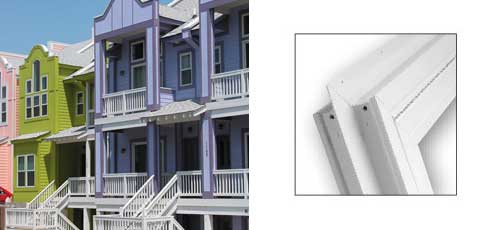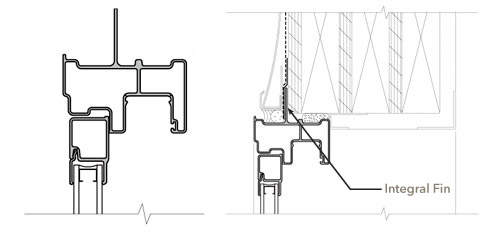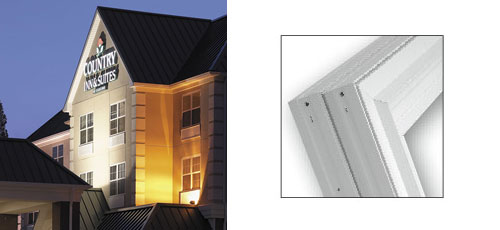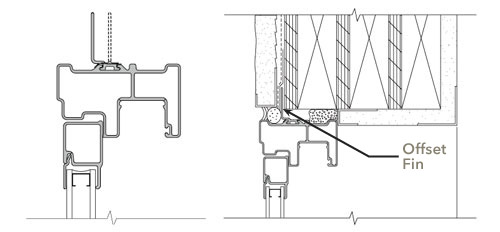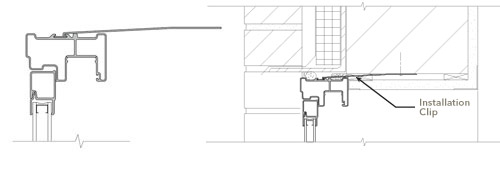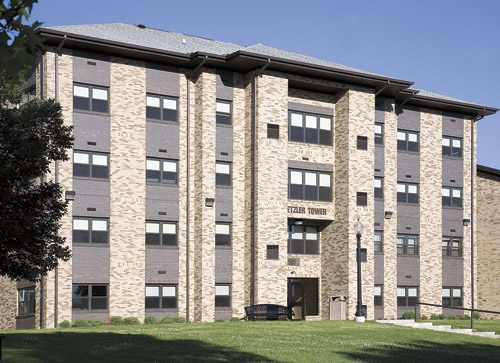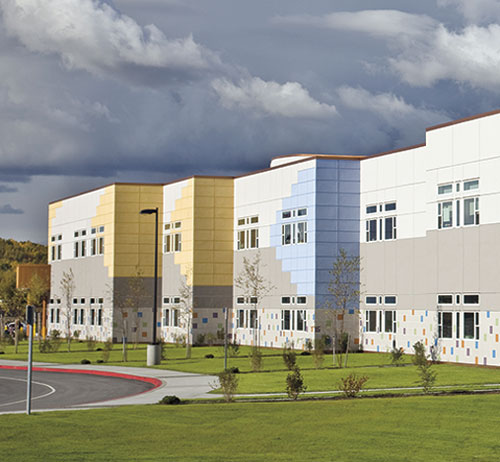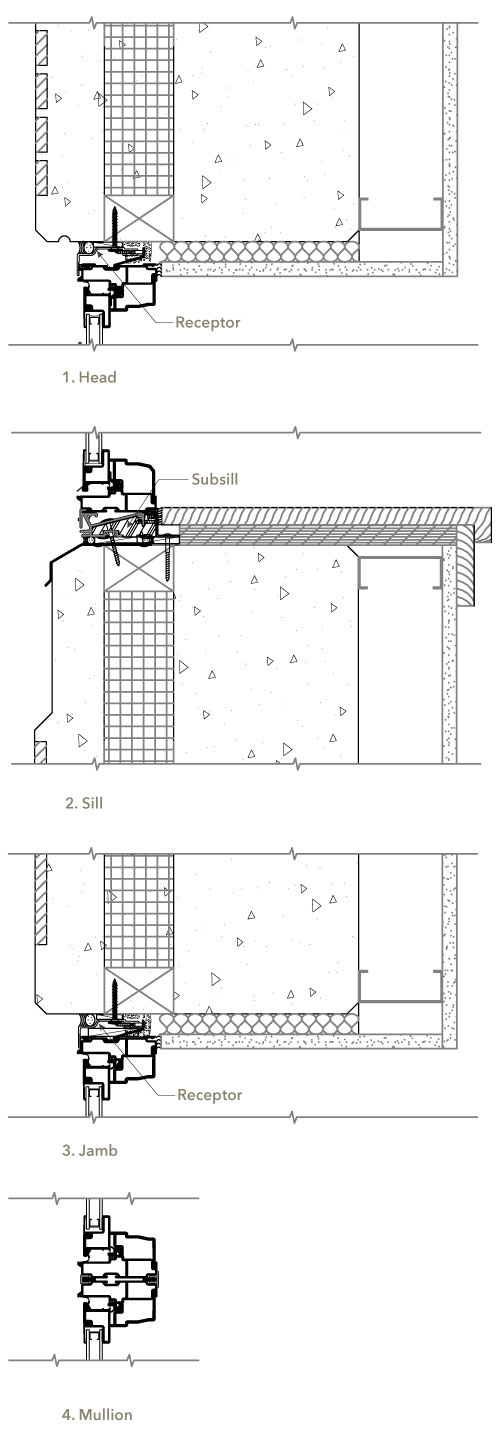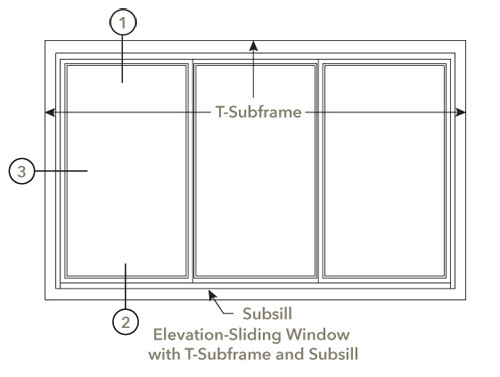This CE Center article is no longer eligible for receiving credits.
Selecting a window system for use in new or renovated commercial and institutional buildings has typically centered on aluminum, steel, aluminum-clad wood, or vinyl windows. In the last five years, however, another choice has gained popularity for a lot of good reasons. Fiberglass window systems are being specified and installed more and more in retail facilities, offices, schools, colleges, condominiums, apartments and many other buildings that commonly have relied only on metal window systems in the past. To understand this emerging trend, let's begin by looking at some of the basics of fiberglass window technology.
Natural Materials Blended with Technology
While the term "fiberglass" is used as if it were a single material, it actually is a composite that consists of glass fibers and a resin that binds those fibers together. Glass fiber, made from natural silica and other materials, has a surprisingly high tensile strength. This characteristic has been demonstrated in many building product applications showing it to act like the equivalent of many reinforcing bars in a concrete mix. The resin that is introduced acts like the concrete itself that forms and holds everything together with the added benefit of performing well in compression. Combined together, the glass fibers and resin create a material that is stronger than either of them individually and provides strength in both compression and tension.
A key point to remember is the type of resin used to make the composite fiberglass material. In general, all resins can be put in one of two categories: thermoplastic or thermoset. In simple terms, thermoplastic materials can be re-melted while thermosets cannot. Most commonly used plastics are made from thermoplastic resin including vinyl windows which are made from PVC, a thermoplastic resin. These materials soften as they are warmed and if heated high enough will melt. This is how plastics are recycled. Thermoset materials, in contrast, undergo an irreversible chemical reaction. Often initiated by heat, once this chemical reaction has occurred, thermosets do not soften or melt as they are reheated. Fiberglass composite windows are made using thermoset resin. As a result, fiberglass composite windows can be used in hot climates and can be painted dark colors, even in high sun exposure applications. If vinyl windows are used in these applications, it is possible for the vinyl to soften, causing the material to sag or warp. The term, "vinyl smile," is sometimes used in the industry to describe this phenomenon. This is most often seen when the head of a large span sags after becoming too hot.
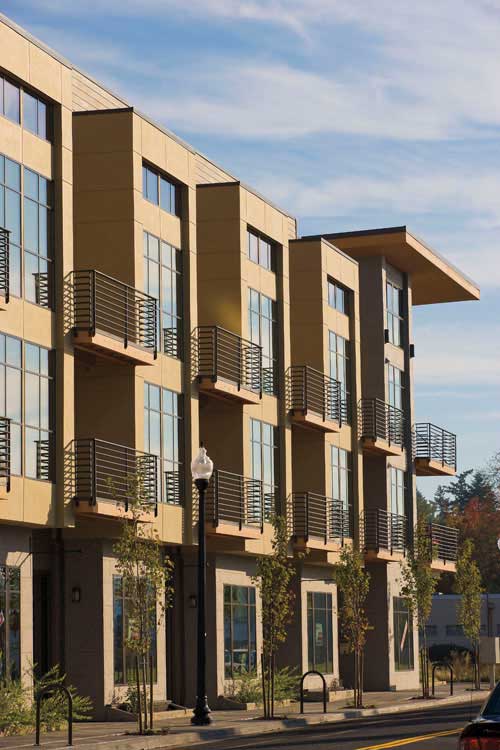 |
Fiberglass windows offer design flexibility for non-residential and multi-family buildings.
Photo courtesy of Pella Corporation |
The process of making fiberglass window frames is also different from making aluminum or vinyl frames where the process of extrusion is used, which means the material is pushed through a die to shape. Instead, fiberglass frames rely on a process called pultrusion, in which thousands of glass fibers (called rovings) are pulled through a steel die. (See Figure 1.)The resin and fiber are given shape as they are pulled through the die which is heated to initiate the resin's cure process. The hardened result is then cut to the desired length and prepared for finishing. A paint finish is applied to the fiberglass to provide the final coloring and UV resistance to protect the finished product from sun exposure. Â In testing performed in accordance with the American Society of Testing and Materials (ASTM) testing standards, fiberglass composites manufactured in this manner consistently display superior performance in strength, ability to withstand extreme heat and cold, and resistance to dents and scratches.
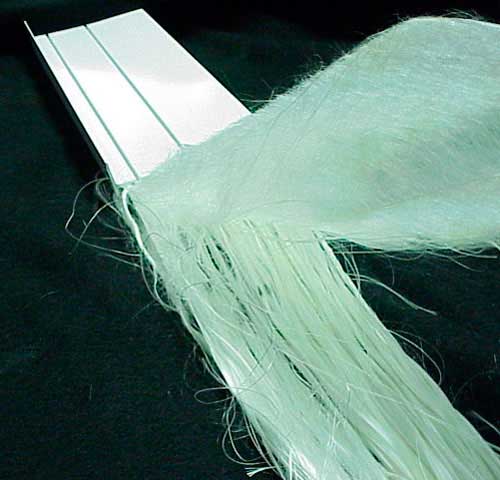 |
Figure 1:Fiberglass being mixed with thermo-set resin in a pultrusion process to form a stable, strong, material.
Photo courtesy of Pella Corporation |
Â
There are several characteristics of fiberglass composite windows that have contributed to their increased use in commercial and institutional buildings, including:
- Durability. In addition to its great strength, certain factory-applied finishes render fiberglass composite virtually indestructible and long lasting. Further, it will not corrode or rot.
- Impact resistance. (See Figure 2.) Fiberglass composite withstands major impacts without deformation, especially in cold weather. Impact resistance is particularly important on the job site during installation, when dents and damage may inadvertently occur.
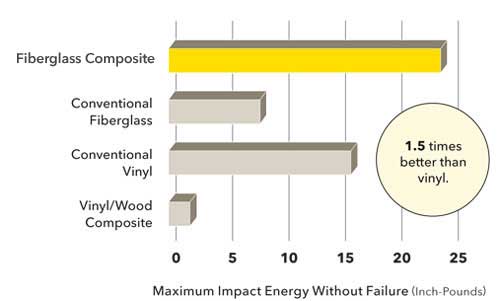 |
Figure 2:Fiberglass impact resistance compared to other window materials
Image courtesy of Pella Corporation |
- Hot and cold performance.Fiberglass composite can handle a wide range of temperature extremes, withstanding heat up to 200 degrees Fahrenheit, and cold to -40 degrees Fahrenheit.
- Thermal expansion. (See Figure 3.) Fiberglass composite has a very low coefficient of expansion which is very similar to glass. As a result, it moves very little as the weather changes, resulting in less stress on the installation, seals, and glazing of the window. In addition, since fiberglass composite is very heat tolerant, it can be painted dark colors without concern for heat deformation.
 |
Figure 3:Fiberglass thermal expansion compared to other window materials
Image courtesy of Pella Corporation |
- Energy efficiency. (See Figure 4a & b.) Fiberglass composites rank high because of their inherently low heat conductivity. Further, they are commonly offered with added insulation inside the cavities of the frames and sash, boosting the overall thermal resistance value of the unit. As a result, the material also has a higher condensation resistance than other materials. As shown in Figure 4a, fiberglass window units rate 2.4 times better than aluminum with a thermal break and even better compared to aluminum frames without a thermal break. As a result, they also provide superior thermal comfort to those seated near windows.
 |
Figure 4a: Fiberglass energy efficiency compared to other window materials.
Image courtesy of Pella Corporation |
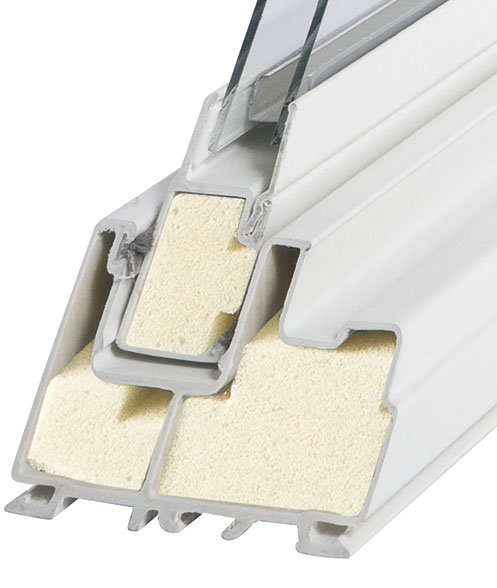 |
Figure 4b: Frames and sash can be filled with foam insulation for added energy efficiency.
Image courtesy of Pella Corporation |
- Sustainability. Fiberglass composites consume less embodied energy to produce when compared to aluminum and vinyl.
- High performance. The finished units provide excellent resistance to air and water infiltration particularly in high winds making them very appropriate for coastal applications. They also serve as effective sound barriers between outdoor and indoor spaces.
- Finish. The final factory applied finish coat is typically scratch resistant, low-maintenance, and resists chalking and fading-even in dark colors.
- Installation, operation and maintenance. Fiberglass composite units typically arrive on-site pre-assembled and pre-finished, which makes them easy to install, and low maintenance over the long term.
The net result of all of these characteristics is that fiberglass composite windows offer an advanced alternative for commercial buildings of all types. They provide exceptional energy efficiency and durability even in extreme weather conditions while combining the beauty of durable finishes with the outstanding performance commercial projects demand.
Window Design Options
In commercial and institutional settings, the windows and fenestration plan play a key role in the overall design and performance of the building. Since variety and customization is often desired, it is important to realize that these options exist from virtually all fiberglass window manufacturers, although to varying degrees. Nonetheless, it is entirely possible to pick a window system that is ideally suited to the needs of a particular project in terms of size, scale, and proportion. In order to grasp this diversity of options, the descriptions below are intended to outline the possibilities in terms of common types, styles and configurations of fiberglass windows.
Operable Windows
In an era when greater natural ventilation is required to meet green building requirements and general human comfort, operable windows are becoming more common in commercial buildings of many types. Of course, they have always been desired or required in multi-family housing and schools, but fiberglass windows often provide more options than have commonly been available before. Maximum window sizes will be determined in part by the type of window selected, but they are generally consistent with the scale and size that would work with most building designs. (See Figure 5.)Â Â Operable fiberglass window options include:
- Single- and double-hung windows. Among the available types, single and double-hung windows are common in some applications. Single-hung windows have a fixed top sash and an operable lower sash, while in double-hung windows, both sash move up and down. Typically all of the operable sashes are removable or tilt-in to allow the exterior glass to be cleaned from inside the building, thereby reducing maintenance costs for exterior cleaning crews, especially in multi-story buildings.
- Casement windows. Commonly available in operable sizes up to approximately 3' wide x 6'-8" high, casement windows feature a typically vertical rectangular or square appearance with side hinged operation. Limited-opening and egress hardware are also commonly available as manufacturer options if needed. Â In terms of cleaning, the sash usually moves toward the center of the frame, making it easy to clean exterior glass from inside the building on any story. Casement windows are typically more energy efficient because the locking hardware lifts and pulls the sash against the weather-stripping to form a tighter air seal than in single or double hung windows.
- Awning windows. Similar in operation to casement windows, awning windows hinge from the top and open out at the bottom with the operating handle located either at the sill or jamb. This arrangement allows for ventilation from below but sheds any unexpected rain falling from above. Commonly available in operable sizes up to 5' wide x 5' high, awning windows can also be configured with optional limited-opening hardware for safety. Awning windows generally use the same type of locking hardware as casements which make them comparable in terms of energy efficiency.
- Sliding windows. Commonly available in two- and three-panel configurations and a variety of sizes, sliding windows can be combined with fixed sash to provide a broad range of design, ventilation and egress solutions at a commonly competitive price point.
 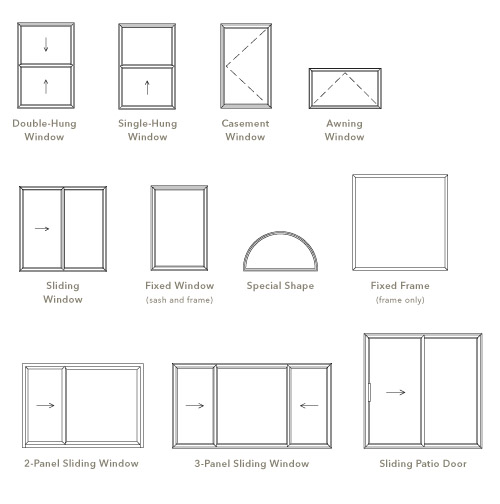 |
Figure 5: Fiberglass windows can be operable or fixed and can come in a variety of shapes and sizes.
Images courtesy of Pella Corporation |
Fixed Windows and Fixed Frames
In situations where operable windows are not needed or desirable, fixed in place units are available in fiberglass and deserve consideration. Not only do fiberglass units offer a similar appearance to other choices, they are commonly available in a variety of shapes as well as sizes. Polygons, arches, circles, trapezoids, and other custom shapes are typically among the design options. (See Figure 6.) There are basically two types of units to choose from depending on the design requirements of a project:
- Fixed windows have an outer frame plus a non-operable sash that holds the glazing. They offer views and natural daylight, but typically at a lower cost than operable windows. Since fixed windows are often paired with operable windows, the pairing of a fixed sash and frame allow the fixed and operable windows to look alike for a consistent appearance and aesthetic effect across the building.Â
- Fixed frames, unlike fixed windows, do not have a sash. They offer the design flexibility of fixed aluminum glazing systems, while providing significantly improved energy efficiency resulting in lower energy costs, better U-Factors, greater resistance to condensation and superior thermal comfort. Unlike aluminum systems that are glazed in the field, fixed fiberglass frames are glazed in a controlled factory environment, maximizing quality while reducing field installation time. And specialty sub-contractors are not typically needed to install these pre-finished, pre-glazed windows, rather, the general contractors may choose to do so with their own workforce. Fixed frames can produce a final effect that allows a range of sightlines to be achieved, depending on how the glass is subdivided to meet the design intent.
  |
Figure 6: Fiberglass windows shown installed in different sizes, shapes, and configurations
Images courtesy of Pella Corporation |
Mullion and Grille Options
Once a window type is selected for use in a building, a common next step is to determine how to group them within the design. Accordingly, fiberglass window manufacturers have offered a variety of options on how to combine multiple units together using mullions or how to subdivide larger units using grilles. Some of the common choices are demonstrated as follows:
- Integral mullion. Two or more units can be combined together with an integral fiberglass mullion that matches the rest of the window unit. In cases that require it, steel can be added to stiffen large units against wind or other loads. (See Figure 7.)
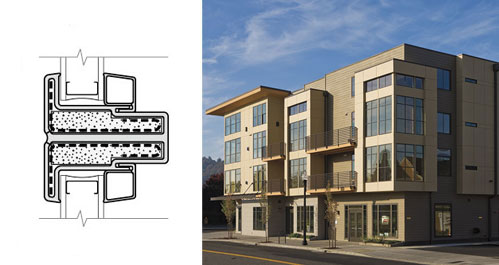 |
Figure 7: Integral mullions allow multiple fiberglass windows to be installed together in a common frame. Optional steel reinforcement shown by dashed lines.
Images courtesy of Pella Corporation |
- Reinforcing mullions. Where structural conditions warrant it, fiberglass windows can be fabricated with a central mullion that will reinforce the unit and help it resist imposed loads. This larger mullion may have positive design implications in terms of the way the trim pieces accentuate the overall appearance of the façade. (See Figure 8.)
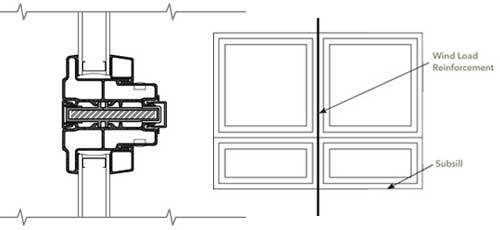
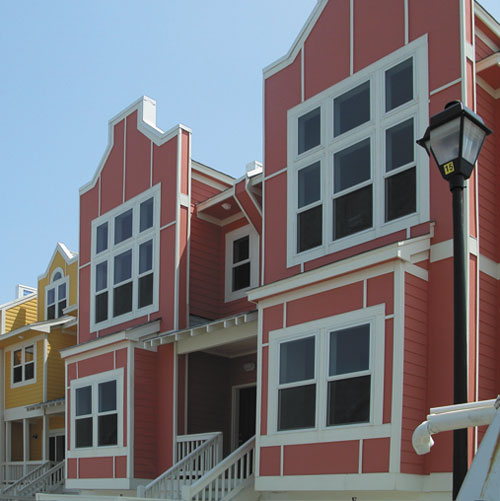 |
Figure 8: Reinforcing mullions are used where structural forces of wind load and or size dictate their need.
Images courtesy of Pella Corporation |
- Grilles-between-the-glass. As with other styles of windows, grilles-between-the-glass, also known as integral muntins, may be placed between the glass panes to provide the look of divided lights. (See Figure 9.)
|
Figure 9: Grilles or muntins can be located between the glazing layers to create a desired appearance, maintain energy efficiency, and make cleaning easier.
Images courtesy of Pella Corporation |
- Applied Grilles. Another way to subdivide the glass is through the use of applied grilles. Since they can match the frame in size and color, they can be used to provide the look of multiple windows or aluminum storefront. They are typically adhered to both the exterior and interior faces of the glass for a similar appearance on both sides. The width of the applied grille can be the same as the frame, to provide a clean, commercial look. The color typically matches the frame on both sides and multiple grille patterns are available. (See Figure 10.)
|
 |
|
Figure 10: Fixed frames with grilles or muntins applied to the inside and outside of the glazing are economical and provide great flexibility in subdividing the glass.
Images courtesy of Pella Corporation |
- Hybrids. In some cases, it is desirable to combine the various techniques in one or more window units. Hence it is possible to specify integral mullions, grilles-between-the-glass, and applied grilles, for example, all to be combined on the same window and create the desired appearance. (See Figure 11.)
|
 |
Figure 11: Fixed frame composites with optional combinations of integral mullions, applied grilles, and grilles-between-the-glass. Mixing and matching window types, glazing styles, grilles and sizes allow for creative variations within a single building design.
Images courtesy of Pella Corporation |
Â
Clearly, the range of options and choices available allow for a wide variety of ways to meet particular design requirements and style preferences. Further, the ability to combine and subdivide units in multiple ways allows for creativity without sacrificing performance.
Design Applications and Case Studies
Incorporating fiberglass window units into a particular building design often comes down to the type of opening that the architecture calls for. Depending on the number and configuration of windows and doors per opening, design recommendations for perimeter clearances, weight limitations, wind loads, and water management may vary. Four types of window design openings are highlighted through the design recommendations and case study examples that follow. Â
Punched Opening into a Façade
Design recommendations
To determine the window opening size for typical punched opening installations, add 3/4" to frame width and height. For punched openings with large windows, multiple windows, out of plumb openings, and/or in masonry construction, the need for additional jamb clearances should be reviewed. Depending on the sequence of construction, many methods of attachment are available for anchoring fiberglass windows to the wall. (See Figure 12.)
|
Figure 12: Dana College dorm utilizing punched opening window design
Images courtesy of Pella Corporation |
Â
Case Study: New dormitory at Dana College, Blair, NE
Architect: RDG Planning and Design |
Selecting windows for a college dormitory poses some unique challenges. At Dana College, a small private campus in Blair, Nebraska, the college president wanted a residential, not institutional, character for the students' suite-style housing. Due to the nature of a typical student population-and previous window problems on campus-durability and abuse resistance were important design criteria, along with budget constraints and energy efficiency.
College vice president and CFO, Bob Schmoll, was in charge of the project. He and the architect looked at other window options, but didn't want to compromise. Based on the architect's final recommendation, fiberglass sliding windows were selected for the project. "Fiberglass windows satisfied these durability needs, and provided flexibility in design, color selection and custom grille patterns-and the college president's design goals were met within our budget," said architect Steven Weber. Schmoll adds that he would definitely recommend fiberglass windows for their quality, durability and functionality.
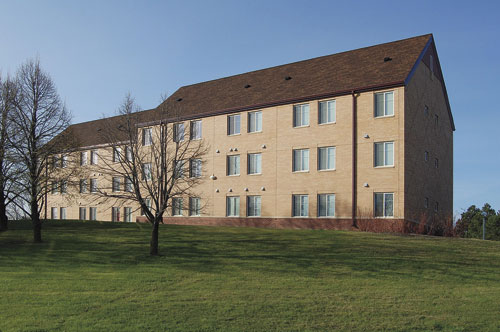
|
Horizontal Ribbon Windows
Design recommendations
In addition to the recommendations for Punched Openings, the greater width of Horizontal Ribbons often requires special head/jamb details, reinforcing mullions, expansion mullions, and subsills to resist wind loads, allow for construction tolerances, and provide adequate water management. Expansion / control mullions are recommended every 20' maximum. Minimum 1/2" clearance is recommended at each jamb for masonry openings greater than 10' in width. Subsill systems that weep incidental moisture to the exterior are recommended for water management in openings like horizontal ribbons where there are multiple vertical joints between windows. (See Figure 13.)
|
Figure 13: West Elementary School utilizing horizontal ribbon windows across the façade.
Images courtesy of Pella Corporation |
Case Study: West Elementary School Renovation |
About 15 miles southwest of Billings, in Laurel, MT, is West Elementary School. It sits beside a playground on 15 grassy acres and accommodates 350 students in kindergarten through fifth grade. Built in 1956, with an addition in 1979, West Elementary School's original aluminum windows served as more of a hindrance than a help in the learning process for both teachers and students and were long overdue for replacement. Noise from the playground distracted the students. Teachers had no control over temperature; it was always either too hot or too cold. The school has no air conditioning, and attempting to open the non-screened single-pane windows for improved airflow resulted in bugs flying in-including bees that would sting the children. During winter, when average outside temperatures range from 15 to 43 degrees, the extremely drafty old windows cost the school extra money on heating bills. The administration for West Elementary School was looking for a functional window that was durable, energy-efficient and low-maintenance.
Roger Heimbigner, business manager for the Laurel School District, was concerned about the budget constraints of a publicly funded building. The project team collaborated to select fiberglass double-hung windows for the school in response to the many needs and criteria imposed on them. The team found the fiberglass windows to be uniquely functional, durable and affordable. Plus, they never need to be painted, so there are no finishing or maintenance costs. Low-E insulating glass improves insulating value, reduces heat gain and offers protection from UV rays, making the windows extremely energy-efficient. The aesthetic goal was to achieve a look that went well with the building construction type. White windows complemented red brick veneer and steel siding, "creating a nice flow throughout the building," Heimbigner noted.
The project didn't start until July, so the contractor had only seven weeks to install 165 units before school began. The original windows had supported two-inch-thick glass blocks above. The intent was to cut the window frames, take the windows out for replacement and leave the glass blocks in place. But since they had been mortared to the windows, the glass blocks had to be removed and replaced with steel panels.
With these construction challenges and such a tight timeline, the general contractor, Bryan West of Fisher Construction, relied on the manufacturer for support. He said, "A representative here in Billings came out to measure and order everything. Then he worked on one or two installations-as training-and it all came together smoothly. Everything fit nicely." West added that his crew of four was able to install as many as five windows a day, completing the job on time and on budget. "The window installation was easy and trouble-free," he said.
Since having the new windows installed, Heimbigner said the school has noticed a significant decrease in noise from the playground coming into the school, as well as savings in heating costs in one year alone. Plus, the screens allow more cool air in when needed while keeping bugs out. He commented, "It's hard to learn when the classroom isn't comfortable. We used to get e-mails all the time from teachers saying the rooms were too hot or too cold. Since installing the new windows, we haven't had a single complaint like that."
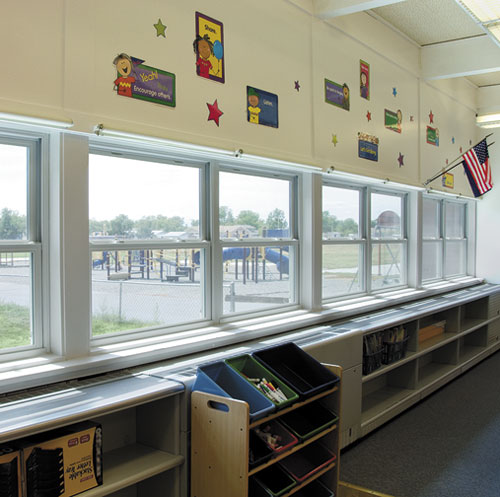
|
Vertically Stacked Windows
Design Recommendations
Similar to horizontal ribbons, the greater height of vertically stacked windows often requires special detailing, reinforcing mullions, intermediate dead load support, and subsills. Operable or fixed windows of the same width can be stacked vertically to a maximum height of ten feet without intermediate dead load support. Intermediate support is typically introduced at the floor lines to carry the weight of the windows above. (See Figure 14.) Â
|
Figure 14: Walsh University Alexis Hall utilizing vertically stacked window design
Images courtesy of Pella Corporation |
Case Study: Alexis Hall, Walsh University, Canton, OH
Architect: Motter & Meadows Architects
General Contractor: Fred Olivieri Construction Company |
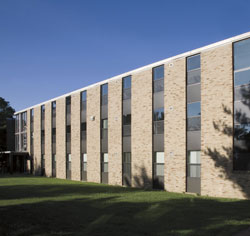 Walsh University needed windows that would withstand day-to-day use by college students, match the style of other buildings on campus, and save energy. Located on 85 sprawling acres and surrounded by an abundance of trees, Walsh University is a private college in Canton, Ohio. Alexis and Menard halls were built in 1968 and together house 400 students. The goal for this project was to replace the existing aluminum windows in Alexis Hall and build the Betzler Tower addition onto Menard Hall. The challenge was finding replacement and new construction windows that matched. The windows needed to be extremely durable and low-maintenance to handle use and abuse by college students, as well as to complement the architectural style of the halls and other campus buildings. The windows also had to be affordable and energy-efficient-so the students would have a comfortable living environment and the school would save on its energy costs. Walsh University needed windows that would withstand day-to-day use by college students, match the style of other buildings on campus, and save energy. Located on 85 sprawling acres and surrounded by an abundance of trees, Walsh University is a private college in Canton, Ohio. Alexis and Menard halls were built in 1968 and together house 400 students. The goal for this project was to replace the existing aluminum windows in Alexis Hall and build the Betzler Tower addition onto Menard Hall. The challenge was finding replacement and new construction windows that matched. The windows needed to be extremely durable and low-maintenance to handle use and abuse by college students, as well as to complement the architectural style of the halls and other campus buildings. The windows also had to be affordable and energy-efficient-so the students would have a comfortable living environment and the school would save on its energy costs.
Walsh University decided to install fiberglass windows for the new addition on Menard Hall and the Alexis Hall replacement project. The brown single-hung windows used for the vertical stacks "matched the buildings' colors and brought Menard Hall and Alexis Hall up to a standard that's acceptable to the university," said Mark Bosko, director of university relations for Walsh University. Installation of Alexis Hall's replacement windows, however, proved to be a challenge. The 40-year-old, clear anodized aluminum windows had been caulked several times and had a brown aluminum panel at each floor line. The existing windows sat flush with precast floors, complicating the installation of new windows. To ensure optimum installation performance, an innovative installation solution was developed at the spandrel locations to cover the concrete slab, seal the windows and prevent joints from showing. The new dark-brown fiberglass windows give a consistent, modern and clean look to the building-and create a place students can be proud to call home.
|
Single-story Storefront Style Systemsp
Design Recommendations
Similar to the opening types noted above, fiberglass storefronts include a combination of windows that often require reinforcing mullions, expansion mullions, and subsills to resist wind loads and allow movement while providing adequate water management. (See Figure 15.)
|
Figure 15: Elevation and details of fiberglass storefront
Images courtesy of Pella Corporation |
Case Study: New Beranger Condominiums, Gresham, OR
Architect: Myhre Group Architects |
The Beranger Condos is a mixed-use complex in downtown Gresham, OR. The four-story structure contains 24 condominium units and 7,000 square feet of ground-level retail space. One of the building's most unique features is its "green roof" that employs cutting-edge environmental technology to manage rainwater-an important concern given Oregon's climate.
Among the highlights of The Beranger Condos' design are the tall windows present in the condo units. While the architect originally specified fixed aluminum storefront for these openings, the building's owner had used aluminum in a previous project and was dissatisfied with their performance. Fiberglass windows provided the quality, aesthetics and cost-effectiveness he was looking for. He was pleased with their exceptionally durable and energy efficient qualities. But equally appealing was the fact that the building's 264 double-hung, fixed frame and horizontal sliding windows were all glazed in a controlled factory environment, saving time and money during the window installation process. The flexibility of the numerous fiberglass window options along with their outstanding performance, helped make The Beranger Condos a welcome addition to downtown Gresham.

|
Fiberglass Window Installation Methods and Details
Part of the beauty of fiberglass windows is that the units can be fully fabricated and delivered to the site pre-finished, pre-glazed, and ready to install. Manufacturers have continued to make the installation process easier by offering standardized methods of installing fiberglass composite windows in either new construction or renovation projects. Some of the standardized types of installation are described and illustrated below:
Integral fin. (See Figure 16.) The integral fin installation method relies on a continuous fiberglass fin or nailing flange that runs around the entire perimeter of the window unit. This feature, allows the window frame to be integrated into the building's weather-resistant barrier using standard installation and fastening methods and flashing tapes. These continuous perimeter nailing fins are used when construction methods permit window and door units to be installed from the exterior prior to the application of exterior cladding, such as lap siding, brick veneer and stucco. The fins provide the surface for nails or other fasteners to be used to anchor the entire unit in place. This method has proven reliable not only in fiberglass windows, but in many other window type applications including aluminum-clad wood and vinyl windows.
|
Figure 16: Integral fin fiberglass windows installed in Bermuda Bay condominiums
Images courtesy of Pella Corporation |
Â
Block frames. The block frame uses a standard frame on all sides of the window unit that can be readily inserted into a rough opening in construction. This standardized frame provides a variety of attachment and installation options for both new construction and renovation projects. Windows can be installed in wood and steel frame openings using optional slide-in fins, in masonry openings using installation clips, jamb screws or receptors, or in window replacement situations using a variety of options. Some of the standard choices are discussed further below:
- Block frame with standard fin or offset fin. (See Figure 17.) Similar to the integral fin, the standard fin or offset fin can be used with the block frame to provide a continuous attachment method that allows the window frame to be integrated into the building's weather-resistant barrier. These slide-in fins are often used in lieu of integral fins when many windows are being joined together in combinations. It allows the fin to be used only where needed, eliminating the need to trim the integral fin in the field. The offset nailing fin is designed for use in new construction with thin exterior claddings like stucco, thus allowing the window to be located more to the interior.
|
Figure 17: Block frame with offset fin to accommodate fa�ade materials used on Country Inn and Suites. Standard fin shown in dashed lines.
Images courtesy of Pella Corporation |
- Block frame with installation clips. (See Figure 18.) This method is intended for new construction or window replacement where wall conditions or construction sequence require installation from inside the building. Unlike fins which are continuous, clips are typically spaced at 18" on center. The clips are secured to the frame and then nailed or otherwise anchored to the wall construction. Because the clip extends beyond the interior of the window frame, it must be covered with gypsum board or trim to conceal it from view.
|
Figure 18: Block frame with installation clip used in dormitories at Walsh University
Images courtesy of Pella Corporation |
- Block frame with screw attachment. (See Figure 19.) Like the installation clip, this method of attachment is typically used when the windows must be installed from inside the building. In this situation, screws penetrate the frame and secure the unit to the building. Since anchorage is through the frame, it works well in solid masonry walls where there are no additional interior finishes besides the block masonry.
|
Figure 19: Block frame with screw attachment used at the Fred and Sara Machetanz Elementary School
Images courtesy of Pella Corporation |
- Block frame with receptor and subsill. (See Figure 20.) Receptors are often used in multistory buildings requiring installation from the interior or when a more robust installation method is desired. First, the subsill is anchored to the sill of the window opening. Then the receptors are anchored to the opening at the head and jambs. Finally, the new window is installed on the top of the subsill and within the receptor system from the interior. Together, these multiple pieces act to assure that the integrity of the window unit and its installation is maintained.
|
Figure 20: Block frame with receptor and subsill installation details
Images courtesy of Pella Corporation |
- Block frame with pocket installation (window replacement). (See Figure 21.) This is an excellent and very economical choice for applications where the existing frames are in good condition and only the sash needs to be replaced. The new window sash are factory assembled into a fiberglass frame that essentially creates a full window unit that is custom made to slide easily into the existing frame or "pocket". Because it is a full unit, it can be tested for compliance with applicable ASTM and other standards. The result is a high quality window with a faster installation that eliminates the cost and complexity of a complete tear-out.
|
Figure 21: Block frame with pocket installation for window replacement
Images courtesy of Pella Corporation |
- Block frame with standard subframe (window replacement). (See Figure 22.) This installation system is typically used when wood windows are being replaced with fiberglass windows. The existing wood sash is removed and the subframe is used to conceal the existing wood window frame while providing a receptor for the new fiberglass window. It allows windows to be installed from the interior of the building, thus reducing labor costs and eliminating the need for exterior scaffolding or lifts.
|
Figure 22: Block frame with standard subframe installation details
Images courtesy of Pella Corporation |
- Block frame with T-subframe (window replacement). (See Figure 23.) This installation system is typically used when metal windows are being replaced with fiberglass windows. Like the standard sub-frame, it allows window replacement from inside the building and offers similar labor and cost benefits.  The T-shaped subframe is used to conceal the existing metal window frames, allowing them to be left in place. Unlike the standard sub-frame, however, the new window is installed flush with the face of the T-subframe creating a different profile and shadow line on the building.
|
Figure 23: Block frame with T-subframe installation details.
Images courtesy of Pella Corporation |
Regardless of the type of building and wall construction that is being employed, then, the techniques of installation and attachment of fiberglass windows has progressed to be able to accommodate almost any commercial installation. The number of different methods that have been standardized and simplified, actually offer architects more freedom of design with the rest of the building without compromising performance, construction, or economy.
  Â
Conclusion
Fiberglass windows are an advanced alternative for commercial buildings of all types. They are designed and manufactured for exceptional energy efficiency and durability, even in extreme weather conditions. They combine the beauty architectural design requires along with the quality construction and outstanding performance commercial projects demand. They are well suited for a variety of different design applications whether horizontal, vertical, or punched window looks are sought. Their installation methods are numerous and suited to a variety of building construction types for both new and existing construction. Regardless of the design intent or installation method used, designing and specifying fiberglass windows into commercial, institutional, and multi-family buildings, yields improved design, better performance, and lasting durability.
Â
Peter J. Arsenault, FAIA, NCARB, LEED-AP is an architect and sustainability consultant based in New York State and writes on topics related to sustainable design and practice solutions nationwide. He can be reached at www.linkedin.com/in/pjaarch
 |
Founded in 1925, Pella Corporation offers aluminum-clad wood, wood, fiberglass, and vinyl windows and doors at varying price points to meet the performance and budgetary requirements of virtually any non-residential or residential project. Products are appropriate for both new construction and renovation projects and are often used in punched openings, entrances, storefronts and window wall applications.
Registered with the American Institute of Architects as a Continuing Education System provider since 1995, Pella is committed to developing quality learning activities in accordance with AIA/CES and Health/Safety/Welfare (HSW) criteria. Pella offers several continuing education programs through  www.pellacommercial.com in addition to this partnership with Architectural Record. Contact Pella Commercial at: 800-84-PELLA or  www.pellacommercial.com or E-mail: commercial@pella.com. |
|


















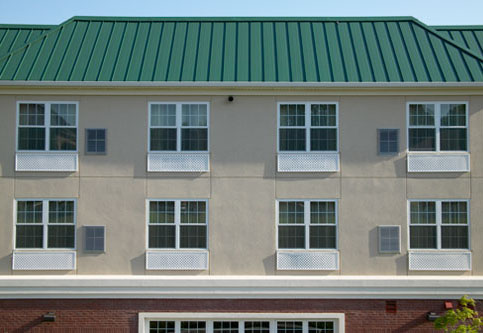



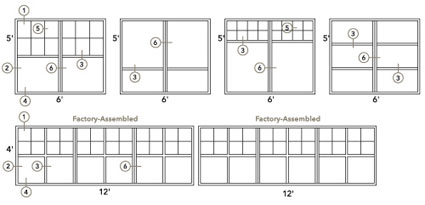


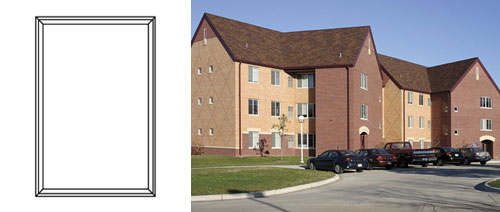

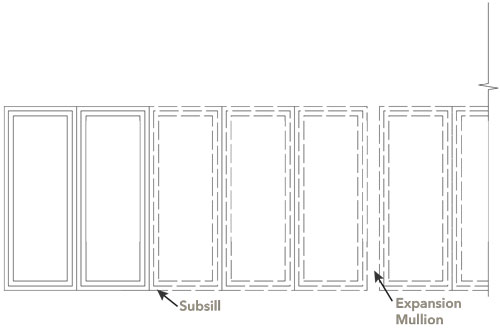
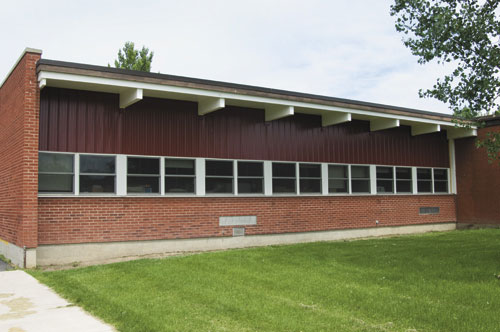

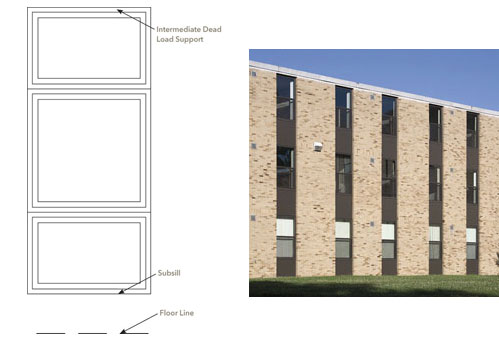
 Walsh University needed windows that would withstand day-to-day use by college students, match the style of other buildings on campus, and save energy. Located on 85 sprawling acres and surrounded by an abundance of trees, Walsh University is a private college in Canton, Ohio. Alexis and Menard halls were built in 1968 and together house 400 students. The goal for this project was to replace the existing aluminum windows in Alexis Hall and build the Betzler Tower addition onto Menard Hall. The challenge was finding replacement and new construction windows that matched. The windows needed to be extremely durable and low-maintenance to handle use and abuse by college students, as well as to complement the architectural style of the halls and other campus buildings. The windows also had to be affordable and energy-efficient-so the students would have a comfortable living environment and the school would save on its energy costs.
Walsh University needed windows that would withstand day-to-day use by college students, match the style of other buildings on campus, and save energy. Located on 85 sprawling acres and surrounded by an abundance of trees, Walsh University is a private college in Canton, Ohio. Alexis and Menard halls were built in 1968 and together house 400 students. The goal for this project was to replace the existing aluminum windows in Alexis Hall and build the Betzler Tower addition onto Menard Hall. The challenge was finding replacement and new construction windows that matched. The windows needed to be extremely durable and low-maintenance to handle use and abuse by college students, as well as to complement the architectural style of the halls and other campus buildings. The windows also had to be affordable and energy-efficient-so the students would have a comfortable living environment and the school would save on its energy costs.